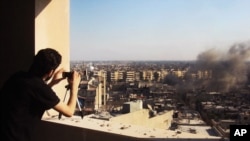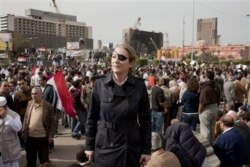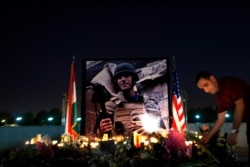In March 2011, tens of thousands of people took to the streets in Syria to demand greater political and media freedoms.
Ten years after the popular uprising against the government of Syrian President Bashar al-Assad, the country remains deeply divided due to a decadelong government crackdown on opposition and dissent, the spread of a violent militancy, and rivalry among regional powers.
For journalists and media observers, their goal to achieve greater media freedoms remains elusive. Conflict in Syria drags on as competing groups vie for control in different parts of the country.
As a result, Syrians throughout the country access news differently. Niche outlets provide information of immediate concern for audiences living in now-separated regions or to the large number of Syrians in displacement camps across the globe.
Syria is one of several Middle East countries that experienced a popular uprising in the early months of 2011. Protests that started in Tunis spread into large-scale rallies that helped topple authoritarian leaders in Tunisia, Egypt and Libya.
But hopes for a path to democracy have been dashed as militants, rival governments and conflicts linger. In nearly all of those countries, governments have moved to crush dissent and critical voices, often using laws that promote national stability or defend against terrorism as cover to imprison journalists and others.
Before and after 2011
“Before 2011, there were no media freedoms in Syria at all,” said Enrico De Angelis, a consultant with Free Press Unlimited (FPU), a press advocacy group based in the Netherlands. “Everything was controlled by the regime. People were mainly using regime-controlled media, as well as private media owned by regime cronies.”
That reality changed after 2011.
“We witnessed a proliferation of different independent media outlets that were mainly born out of the grassroots movements of the anti-regime opposition. Suddenly, you have a diversification of media consumption in Syria,” De Angelis said.
Funded by European and American nonprofit organizations, a significant number of what came to be known as alternative media outlets began to broadcast news in Syria following 2011, particularly in areas where rebels and other anti-government forces were in control.
At the same time, conditions for these emerging media outlets and established journalists became more dangerous. Before 2011, no journalist had been killed in direct relation to their work in Syria, according to the New York-based Committee to Protect Journalists. But that changed when freelance cameraman Ferzat Jarban was arrested covering the rallies in November of that year. His eyes were gouged, and his body found on a roadside “severely mutilated,” after, the media advocacy group described the aftermath of his killing.
Since then, a total of 139 journalists have been killed, including international correspondent Marie Colvin, an American journalist who worked for the British newspaper The Sunday Times. Colvin was killed along with French photojournalist Remi Ochlik, when Syrian forces shelled their makeshift media center. U.S. journalists James Foley and Steven Sotloff were also taken hostage and later murdered by the Islamic State, in yet another gruesome beheading video that captured the world’s attention.
Fragmented country
Today, Syria is fragmented into three areas: the northeast, controlled by the U.S.-backed Syrian Democratic Forces; the northwest, mostly controlled by Turkey-backed militia groups and other Islamist elements; and the rest of the country, controlled by Syrian government forces and its allied militias, many of whom are backed by Iran.
Such political and military dynamics, observers say, reflect on the way Syrians consume news in each of these areas.
“This political division and localization of the Syrian conflict over the past 10 years has made Syrians in each of these zones of influence largely concerned about what happens in their respective areas,” said Siruan Hadsch Hossein, founder and director of Arta FM radio news station.
Arta FM is a community radio station operating in northeast Syria and was founded in 2013. It broadcasts in Arabic, Kurdish and Syriac and is mostly funded by a U.S. State Department program and other European grants. The radio station aired programs ranging from hard news to live discussions focusing on topics of local interests.
Hossein says the multifaceted nature of the Syrian war, coupled with various regional and international participants involved in the conflict, has inevitably forced Syrians to care mainly about what takes place in their immediate environment.
“In the early years of the uprising, if something happened in Daraa (in southern Syria), people in Amuda (in northern Syria) would closely follow it. But right now, this is no longer the case,” he told VOA.
“People in Daraa have a long list of problems to care about, and so do people in Amuda,” Hossein said.
Accordingly, when Arta FM creates news content, it makes sure it caters directly to its local audience.
In a recent editorial meeting, Hossein and his colleagues decided to dedicate greater coverage to the rising prices of commodities in northeast Syria. Observing the market, Arta journalists realized that the recent uptick in prices was not a nationwide trend. It was largely because of custom fees imposed by local authorities and those in neighboring Iraqi Kurdistan, Hossein said.
“And this is exactly the type of news that our listeners care about right now. Things that directly impact their lives and livelihoods,” he said.
Different areas, different priorities
Ahmed al-Kaddour, who used to run Radio Alwan in the northwestern province of Idlib, agrees about the importance of localized news.
“In an area like Idlib, where the vast majority of the current population has been displaced from other parts of the country, the most important piece of news for people on almost a daily basis would be news about their original regions,” he told VOA.
Radio Alwan is one of several community radio stations that were founded in 2013.
Broadcasting to the Idlib town of Saraqib and its surroundings, the station played a major role in spreading neutral news about the country’s conflict. Its operations ceased in December 2019 after funding dried up for all independent media outlets, Kaddour said.
Kaddour, who currently lives in Washington, D.C., said while militant groups, including the powerful Hayat Tahrir al-Sham, have consolidated power in Idlib, residents of the embattled province have largely relied on social media and messaging apps to get their news.
“The lack of independent local media and scarcity of electricity to access pan-Arab media, for example, has left Idlib residents with no option but to depend on Facebook and other social media platforms to get their news,” he said.
It is nearly the same for the millions of displaced Syrians, he added.
According to the United Nations, about 5.6 million Syrians are registered as refugees in neighboring countries. There are also 6.2 million people internally displaced within the country.
“What really matters to the majority of these people is any news about the situation of their areas in Syria and ways to travel to Europe,” Kaddour said.
Even in regime-held areas, media consumption has changed significantly during the country’s conflict, FPU’s De Angelis said.
With access to social media and other nontraditional news outlets, “it’s possible for many people to try to access more balanced information” and not only rely on the government’s narrative of the events unfolding in the country, he said.







